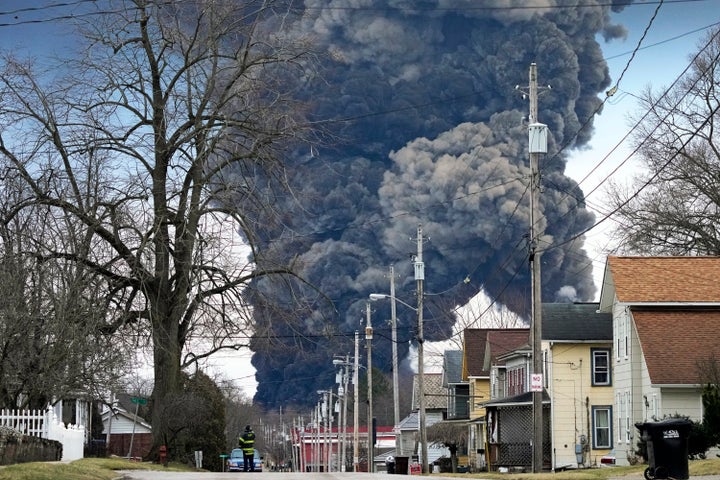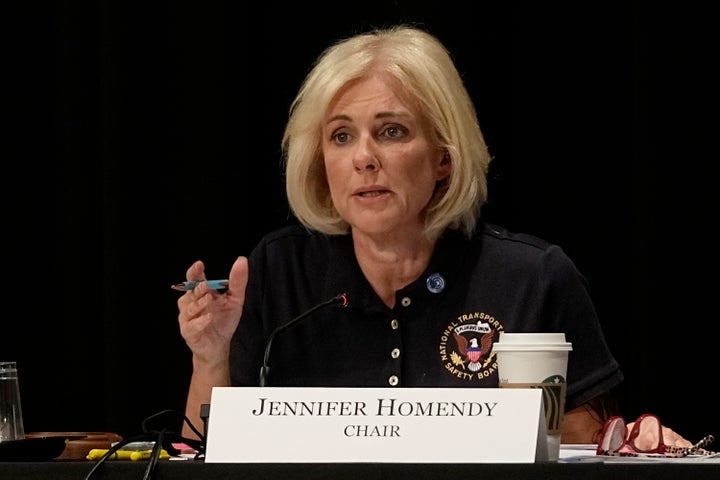The decision to blow up five tanker cars loaded with toxic chemicals following the fiery derailment of a train in East Palestine, Ohio, last year was unjustified, federal investigators concluded Tuesday.
The freight train cars full of vinyl chloride, a cancer-causing chemical used to make plastic, were burned three days after the train careened off the tracks and released massive plumes of toxic smoke into the sky.
As incident commander, East Palestine fire chief Keith Drabick ultimately gave Norfolk Southern, the train’s operator, the green light to torch the cars. He told federal investigators last year that Norfolk Southern and its contractors presented intentional burning as the only viable and safe option, and gave him 13 minutes to make the decision — a request that he said left him “blindsided.”
Norfolk Southern has repeatedly defended the move, citing the purported risk of the tanker cars suddenly exploding.
But the National Transportation and Safety Board threw cold water on that narrative Tuesday during a hearing on the findings of the agency’s lengthy investigation into the Feb. 3, 2023, derailment.
Investigators said there was no imminent sign of the chemical reaction, known as polymerization, that would’ve cause tank cars to explode. They said Norfolk Southern and its contractors “misinterpreted and disregarded evidence” in advocating for what’s known as a vent and burn operation, which involved blasting holes in tanker cars, draining the vinyl chloride into pits in the ground and setting it on fire.
“Norfolk Southern and its contractors continued to assert the necessity of a vent and burn, even though available evidence should have led them to re-evaluate their initial conclusions,” Paul Stancil, a hazardous materials investigator at the NTSB, said Tuesday.

Norfolk Southern overlooked alternatives and “compromised the integrity of the vent and burn decision by withholding complete and accurate expert opinions and information from the incident commander,” Stancil said. He noted that representatives of OxyVinyls, the company that manufactured the vinyl chloride onboard the train, repeatedly told the railroad that there were no signs of polymerization in the tanker cars, but that assessment was not relayed to the incident command team.
“The pattern of dismissing contradictory evidence while interpreting ambiguous evidence in support of Norfolk Southern’s and its contractors’ original belief was consistent with confirmation bias,” he said. “Whatever the underlying explanations were for the continued support of a vent and burn action, none justifies failing to communicate accurate and complete information, including dissenting expert opinions, to the incident command.”
NTSB made a number of recommendations on Tuesday, including that Norfolk Southern update its incident report to accurately represent the facts surrounding the burn decision and that the Federal Railroad Administration revise its guidance for when venting and burning chemicals is appropriate.
“Although a vent and burn action was not necessary in East Palestine to prevent a polymerization-induced catastrophic tank rupture, such action could be appropriate under different circumstances,” Stancil said. “The significant impact of a vent and burn action to a community demonstrates the need for widely available federal guidance on what circumstances and what products are warranted for the procedure.”
The vent and burn operation has received widespread scrutiny from scientists, lawmakers and current and former federal employees, as HuffPost previously reported. Some experts, including a retired Environmental Protection Agency official of nearly 40 years who spoke exclusively with HuffPost, have slammed the EPA for not stepping in to prevent the chemical burn. EPA has said it was not consulted on the final decision and that the incident command team was presented with “no feasible option” that did not include releasing vinyl chloride.
The vent and burn exposed area residents to potentially dozens of different chemicals at once. As HuffPost previously reported, it’s not known how such chemical cocktails can harm human health.

In an statement Tuesday, Norfolk Southern maintained there was a “strong possibility of a catastrophic, uncontrolled explosion,” disputed the board’s conclusion that the company “withheld” information and blamed OxyVinyls for not sufficiently warning decision-makers on the ground.
“The vent and burn effectively avoided a potential uncontrolled explosion.,” the rail company said in its statement. “There was no loss of life and contractors took steps to manage environmental impact.”
“The vent and burn effectively avoided a potential uncontrolled explosion,” the rail company said in its statement. “There was no loss of life, injuries, or damage to property, and contractors took steps to manage environmental impact.”
In her opening remarks at Tuesday’s hearing, NTSB Chair Jennifer Homendy apologized to the residents of East Palestine and surrounding communities, which are still reeling from the chemical disaster.
“Unfortunately, some have sought to minimize the wide-ranging impacts of this derailment, pointing to the fact that there were no fatalities or injuries,” she said. “For this, we are certainly grateful, but the absence of a fatality or injury doesn’t mean the presence of safety.”
Homenday, who first outlined a lack of evidence to support the vent and burn operation during a March Senate hearing, called Norfolk Southern’s response to the safety board’s findings “insulting” and “disgusting.”
As part of its investigation, Homenday said NTSB obtained text messages in which Norfolk Southern employees described the drastic scene during the vent and burn, including a picture of the smoke plume taken from an airplane, as “cool.”
“It’s not ‘cool,’” Homenday said on Tuesday, voicing concern about the risks it posed to area residents.
The NTSB was scheduled to vote on adopting the investigative report at the end of Tuesday’s hearing, and the final report is expected to be publicly released within four weeks.







